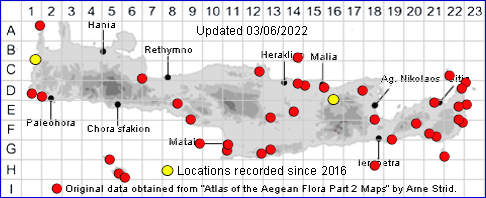

SPECIES DESCRIPTION
NIGELLA DOERFLERI
Family and Genus:- See- RANUNCULACEAE
Common Names:- None
Homotypic Synonyms:- None
Meaning:- Nigella (L) Blackish, (reference to the seed coats).
Doerfleri (L) For the Austrian botanist Ignaz Dorfler (1866-1950).
General description:- Herbaceous plant.
Stems:-
1) Erect, slender, usually sparingly branched near the base, 5-15 cm tall.
Leaves:-
1) Basal, pinnatisect, with rather few, broadly oblanceolate, laciniae.
2) Cauline, few, pure green, near to linear-oblanceolate, relatively short laciniae.
3) Uppermost internode, 2-6(-15 mm); involucre absent.
Flower:-
1) Small, (9-15 mm across).
2) Sepals, white, with a faint network of greenish veins near the apex;
a) limb, 3.5-5 x 2-3 mm acuminate, cuneate to obtuse at the base.
b) claw, about half as long as the limb.
3) Honey leaves, small; lobes of lower the lip, pale yellowish-green, with 2
conspicuous green glands but without transverse bands.
4) Anthers, obtuse or mucronate, yellowish; pollen pale yellow.
Fruit:-
1) Follicles, 8-13 mm, slightly divergent, united to 65-80%; beak rigid, about half as
long as the follicle.
2) Seeds, 2-2.4 x 1.3-1.6 mm, densely and finely tuberculate, black.
Key features:-
1) Flowers, small 9-15 mm across.
2) Honey leaves, small.
3) Lobes of the lower the lip, pale yellowish-green.
4) Follicles, united to 65-80% of their length.
Habitat:- Open patches in dry open shrubby vegetation, generally in dry rocky
habitats on various substrates, also on small islands. 0-300(-600) m.
Distribution:- Endemic Crete, and to the Cardaegean area occurring also on many
small islands. Rare and sporadic on Crete.
Flowering time:- Mid-Apr to mid-May
Photos by:- Steve Lenton
